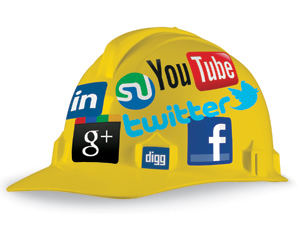
As more contractors and design firms build online presence and promote their brand via social media, some—but not all—are beginning to develop formal company policies and programs to guide employee behavior and manage risks.
Sporadic efforts have lately become an onrush, says Ronald Worth, chief executive officer for the Society of Marketing Professional Services, Alexandria, Va., who likens it to the adoption of the iPad. Still, Worth estimates only about 15% of those firms are producing company social media policies.
Policy or not, Worth adds that the big trend is toward “thought leadership” or content marketing, both of which essentially refer to the same thing. It’s the practice of groups using non-company-related information and content to promote themselves as thought leaders.
Engineer Burns & McDonnell (burnsmcd.com) is one firm that’s jumped aboard the social media bandwagon recently, initiating a formal program this past March. The company has posted quick positive results, says Kevin Fox, senior marketing communications manager. Burns & McDonnell has experienced a 30% gain in followers across its social media channels—which include Twitter, Facebook, LinkedIn and Youtube—and says it’s outdistancing its competitors in terms of online views and visitors.
The company has even managed to optimize its site to the point of becoming the top search result on Google for “engineering company.”
 |
| FOX |
In addition to formalizing a social media policy, Burns & McDonnell also conducts training classes to instruct employees on how to communicate effectively and appropriately.
“I don’t see the social space any differently than I do any other activity where our employee-owners would be interacting with clients and friends,” Fox adds. “If you teach your staff how to talk about the company and how to interact with the public regarding the company, then these platforms are not an issue.”
Burns & McDonnell has a laundry list of “Don’ts” for how its employees use social media.
For instance, employees may speak about the company, but not on its behalf. Also, employees may not set up any online accounts, including personal ones, that use the company’s name or logo without first checking with the corporate marketing department. And using social media for personal purposes during work hours is discouraged.
Another key reminder warns against associating the firm with any kind of personal online comment that could be deemed inappropriate or offensive. If such a connection is made, the policy warns, “these will become part of Burns & McDonnell’s brand presence online.”



Post a comment to this article
Report Abusive Comment